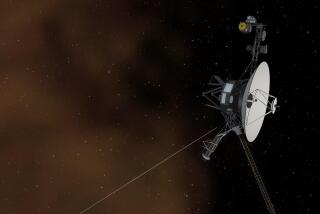Vigil Continues for Signal From British Spacecraft
Hopes for the success of Britainâs Beagle 2 Mars lander dimmed Thursday as mission controllers passed a full day without hearing from the wayward probe.
The craft -- the first European space probe to attempt a landing on Mars -- missed its first two chances to communicate with earthbound engineers, and a hint of pessimism was beginning to creep into the hitherto confident pronouncements from the control room at Londonâs Open University.
Researchers had hoped to contact Beagle 2 when NASAâs Mars Odyssey orbiter flew over the Isidis Planitia landing site 2 1/2 hours after the scheduled landing, but the satellite reported no contact.
About 18 hours later, astronomers turned Britainâs massive Jodrell Bank radio telescope toward Mars as the planetâs rotation brought the lander into line of sight with Earth, but the two-hour observation window passed without a signal being received.
âA search for a Beagle 2 radio signal was carried out this evening without success,â read a concise note posted on the spacecraftâs Web site.
âThis is a bit disappointing, but itâs not the end of the world,â said astronomer Colin Pillinger, lead scientist for the Beagle 2 project.
The next opportunity for contact will be today at 10:15 a.m. PST, when Mars Odyssey passes over the site again.
Engineers will have daily opportunities for contact through Odyssey, Jodrell Bank and a radio telescope at Stanford University.
Beagle 2 will not have an opportunity to contact its mother ship, Mars Express, until Jan. 3, by which time that craftâs orbit will have been adjusted to bring it into a suitable receiving position.
âWe still have 14 contacts with Odyssey programmed into our computer and we also have the opportunity to communicate through Mars Express,â Pillinger said.
Mars Express entered orbit Wednesday at about the same time Beagle was scheduled to land on the Red Planet. Several hours later, the orbiter pointed its main antenna toward Earth, signaling to the waiting scientists that all was well.
âAt least the initial checks show that the spacecraft is in very good position,â said flight director Michael McKay.
There are several possible explanations for the lack of a signal from Beagle 2. The 26-inch-wide craft may have had problems opening its pocket watch-like pod or extending its antenna. It might have ended up in a depression that is blocking communication, or a glitch may have occurred in its internal clock so that it is hailing Odyssey or earthbound telescopes at the wrong times.
In the worst-case scenarios, its parachute may have failed to deploy during the landing phase or it may have struck a sharp rock that broke it.
Beagle 2, named after the ship that carried biologist Charles Darwin to the Galapagos Islands in the 1830s, is the first of three landers scheduled to arrive on the Red Planet over the next month, part of an intensive effort to find signs of life.
NASA has two landers -- Spirit and Opportunity -- scheduled to arrive Jan. 3 and Jan. 24.
The loss of Beagle 2, which cost about $350 million to build and fly to Mars, would be a setback to the European space program, but it would not be totally unexpected.
The mission has been touted by the European Space Agency as the least expensive trip to Mars to date, and officials always have conceded that a low cost carries a higher risk of failure.
More to Read
Sign up for Essential California
The most important California stories and recommendations in your inbox every morning.
You may occasionally receive promotional content from the Los Angeles Times.










